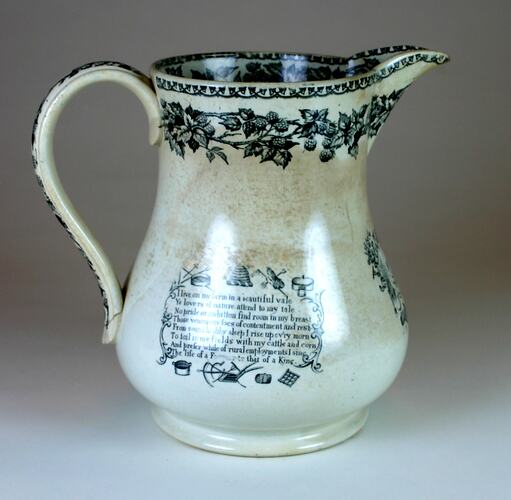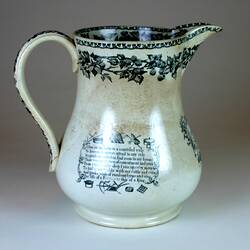Front
Images (clockwise from top)
Beehive and bees
Flowers etc
Sheaf of wheat, scythe, flail and pitchfork
Measure
Plough, shovel, mallet, pitchfork and hoe
Mittens and hay knife
Shears
Sieve
Harrow
Wooden castrell
Sickle
Shovel
Sheaf of wheat and rake
Axe/hatchet
Text (from top)
'God Speed the Plough' banner
'The Husbandmans Diligence Provides the Bread'
Left
Images (clockwise from top)
Beehive and bees
Hoe, pitchfork and harrow
Hay bale, bread (?)
Wooden castrell
Plough, rake, scythe and sickle, flail
Measure
Decorative border
Sieve, pitchfork, mallet and flail
Text
No Title, extract from 'The Happy Farmer'.
This poem is attributed to Edward Williams (1747-1826), a.k.a. Iolo Morganwg, a Welsh poet. Full text is five stanzas long.
Right
Images (clockwise from top)
Beehive and bees
Decorative border
Flowers/leaves
Rake, pitchfork, hoe and sack of wheat (?)
Sickle
Scythe
Sieve
Wooden castrell
Plough, shears and pitchfork
Harrow
Measure
Sickle
Sheaf of wheat, pitchfork and flail
Text (from top)
'The Farmers Creed' banner
'The Farmers Creed'
The attribution of this poem to a particular author varies. References include: West River Farming Society (Canada) 1817 minute book; Board of Agriculture 1793 (Scotland) credited to Sir John Sinclair; handwritten note in dictionary circa 1760-1770, credited to Sir John Simpson.
'God Speed the Plough' banner
Rim/Handle
Images
Topmost of rim (both sides) is a paired leaf pattern
Rim (both sides) and handle has berry (blackberry/raspberry) plant border
Symbolism
Many of the images printed on the jug are associated with agriculture and harvest time. In general, harvest is a time for reaping and is a type of judgement-day. Many of the particular agricultural implements and images found on the jug are associated with fertility, such as flowers, a plough, shovel, hoe, harrow, sickle, scythe and flail. The bees and beehives symbolise industry, diligence, Mother Nature and abundance; speaking of individual and community characteristics of the farmers. The measure similarly depicts fruitfulness and abundance, and flowers festivity and joy. Likewise, the axe may represent the sky gods and the fecundity of rain, and the sieve, purification. The plough symbolises man's mastery over the earth, while the flail, pitchfork and mallet are also associated with male activity and force. Interestingly, the shears possibly speak more about the tenuous nature of farming and the harvest, representing fate and death; both union and severance.
References:
Cooper, J.C. (1978). An Illustrated Encyclopaedia of Traditional Symbols, Thames and Hudson, London
De Vries, A. (1984). Dictionary of Symbols and Imagery, North Holland Publishing Company, Amsterdam & London
Garlick, R. & Mathias, R. (eds) (1984). Anglo-Welsh Poetry 1480-1980. Poetry Wales, Brigend, Mid Glamorgan
Kay, J. (1838). A Series of Original Portraits and Caricature Etchings. Vol. 2, Part 1. H. Paton, Carver & Gilder, Edinburgh
Patterson, G. (1877). A History of the County of Pictou, Montreal Dawson, Pictau, Nova Scotia
St. Swithin, (1911), 'The Farmer's Creed', Notes and Queries, s11 IV July 1 1911, p.6
More Information
-
Keywords
-
Authors
-
Article types

